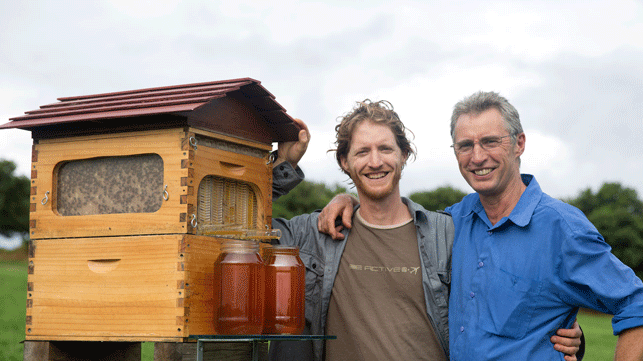A new beekeeping invention is causing something of a buzz. As Tanya Weaver gets to grips with it she thinks we should all be open to innovations and tools that could potentially improve our working practices
As a beekeeper I’m pretty used to receiving all manner of bee-related tweets, Facebook messages, emails, texts and whatsapps. So, when the launch of a new beekeeping innovation went viral in the mainstream press recently, I couldn’t count the times I was pinged a link to it.

Cedar and Stuart Anderson with their Flow Hive that enables honey on tap directly from the beehive
It’s called the Flow Hive. The work of a father and son beekeeping team in Australia, its aim is to ease the honey harvesting process. The beekeeper doesn’t even have to open the hive to extract the honey, it comes flowing out in one delicious golden stream through a tube straight into a jar.
Just a quick bit of background about how the ladies in the hive operate. The queen lays her eggs and the bees rear the young in the brood box. They then store the honey in the super, which is above the brood box. Depending on how prolific the bees are, they can fill up to four supers, which contain around ten frames each.
A full super can weigh an immense 40kg. Once the combs in the supers are capped, the beekeeper will take the entire box to an extraction facility (or kitchen in my case).
So along comes a new kit on the block proposing that all this back breaking, time consuming and sticky work could be a thing of the past.
With help from Australian industrial design consultants Katapult Design, the innovation of the Flow Hive really lies in the frames of the super box. These consist of partly formed honeycomb cells that the bees will build out with wax and then fill with honey.
Once capped off, the beekeeper inserts a rod into a gap at the top of the frames and turns. This then causes the frames to effectively split and creates channels inside the comb for the honey to slide down and into a tube inserted into the bottom of the frame.
This spilt-cell technology has been patented and a good illustration of it can be seen at honeyflow.com.
Meanwhile, back in the hive, the bees are virtually undisturbed on the comb surface as the honey drains from under their feet. To reset the comb, the lever is simply turned back and the process begins again.
Following ten years in the prototyping and testing phase, the innovation was ready for market. In order to fund the expensive tooling, the pair launched an Indiegogo crowdfunding campaign on 22 February with a modest goal of US $70,000. Within 24 hours $2.18 million had been raised and at the time of going to press that amount stands at an incredible $5,769,091.
So, what does the beekeeping fraternity make of it? Obviously there are many who are buying into it but there are equally as many who aren’t. In my experience, the majority of beekeepers are a conservative and traditional bunch who are pretty stuck in their ways and like using tried and tested tools and methods.
I’m a member of the British Beekeepers Association (BBKA) Facebook page and many a beekeeper on there has had a bee in their bonnet about it, and not in an accepting way.
One comment that proves my point perfectly was posted by a Lancashire beekeeper who had a photo of the Flow Hive together with one of a skep (a traditional woven beehive dating back 2000 years!) with a caption: “New product on the market and old product. I know which one I prefer. I am old fashioned…”.
This did make me think that many of us are creatures of habit, stuck in our own ways of doing things.
We are often very wary of new innovations or technologies that could alter this. Like beekeepers, engineers also have a reputation for being conservative when it comes to the tools they use.
Consider the early days of CAD. I wonder how many doggedly hung onto their drawing boards, compass sets and markers before having to relent and take the plunge into the virtual world. But, if you think about it, CAD has come a very long way in a very short time. I’m sure many engineers can still remember this time before the computer.
Over the years, CAD vendors have periodically launched new releases with updates and new features.
However, there is a brand new CAD tool that is set to shake everything up. Its name is Onshape. It’s using the latest cloud/web/mobile technologies to rewrite the rulebook on CAD products and pricing.
Onshape’s CEO, Jon Hirschtick, gave a keynote at DEVELOP3D LIVE on 26 March entitled ‘The Design World Has Changed — How CAD Needs to Change With It’. He discusses Onshape in detail with Al Dean in this article.
Check the DEVELOP3D LIVE page regularly, as we’ll be posting Jon’s talk, along with those of all the other inspiring speakers!
Opening ourselves up to a world of new ideas, tools and possibilities
Default






